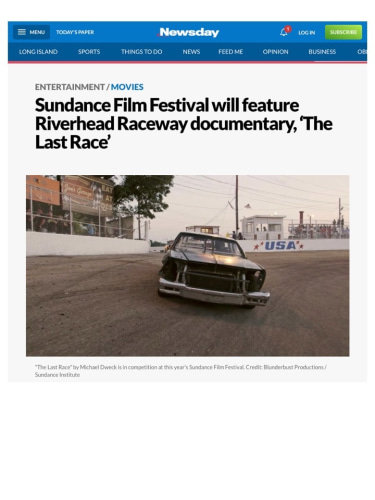Sundance Film Festival will feature Riverhead Raceway documentary, ‘The Last Race’
Newsday
01/25/2018
Back
By Rafer Guzmán
Stock car racing may have faded from Long Island, but at one point it was one of the area’s predominant sports. Filmmaker Michael Dweck, who grew up in Bellmore during the 1960s, looked up to regional racers like Wink Herold the way other kids looked up to baseball heroes like Willie Mays. For most of his childhood, the young Dweck could be found at the races at least twice a week.
“Both my parents took me to the racetrack. That was what there was to do,” says Dweck, whose accountant father moved his family from Brooklyn to Long Island in 1960. “Imagine being a 5-year-old kid, and you get to watch these cars crashing into each other and catching on fire. And then you go to the pits, and you get an autograph from your hero.”
Dweck, 60, belongs to a postwar generation of Long Islanders who can remember when the region was dotted with auto-racing tracks, from Freeport to Deer Park to Islip. Today there is only one: Riverhead Raceway, the subject of Dweck’s debut documentary, “The Last Race.” Earlier this week Dweck attended the Sundance Film Festival in Park City, Utah, for the world premiere of “The Last Race,” which has been chosen along with 15 other films to be part of the U.S. Documentary Competition.
Four years in the making and clocking in at a sleek 74 minutes, “The Last Race” presents a series of portraits-in-motion taken at the ramshackle raceway, which first opened as a dirt track in 1951. Dweck, a former advertising executive and now a respected photographer (his 2002 book, “The End: Montauk, N.Y.,” focused on the area’s surfing culture), first approached Riverhead Raceway with a large-format still camera, not a movie camera.
“But I realized it’s impossible to capture the emotion and the motion of that place with photographs,” Dweck says, speaking by phone from Sundance. “So I decided: Let’s try a documentary.”
For his first-ever film, Dweck made some bold choices. He asked drivers for permission to spot-weld cameras all over their cars — some pointing inside, some pointing outside — including the front bumpers, back bumpers, hoods, trunks and sides. He installed microphones in the tailpipes and inside drivers’ helmets to capture their breathing. The resulting footage (the cinematography is by Gregory Kershaw) captures just about every possible aspect of down-and-dirty stock-car racing.
Two of the film’s main characters are Jim and Barbara Cromarty, spouses in their late 80s who began running Riverhead Raceway in 1977, purchased it in 1985 and held on to it even as retail and commercial growth drove their property’s value into the millions. In 2015 — the year Dweck shot the last of his 340 hours of footage — the Cromartys finally sold the track for $4 million to another husband-and-wife team, Eddie and Connie Partridge of Wading River, who also own a NASCAR team.
“I just don’t want racing to disappear from Long Island,” Dweck says. “We don’t have gladiators anymore, but we have this. And that’s important. I’m hoping the film raises awareness of that.”
“The Last Race” isn’t the only documentary to bring Long Island to Sundance this year. Also in the U.S. competition is “Three Identical Strangers,” which revisits the bizarre story of three men who discovered they were triplets born at Long Island Jewish Medical Center but were given to separate families as part of a secret behavioral study. Screening out of competition are “Bad Reputation,” about the Long Beach rock legend Joan Jett (whose hits include “I Love Rock ’n Roll” and “Crimson and Clover”), and “Science Fair,” which looks at students from around the world — including several from Jericho High School — as they compete at the annual International Science and Engineering Fair. That film’s co-director, Darren Foster, was raised in Island Park.